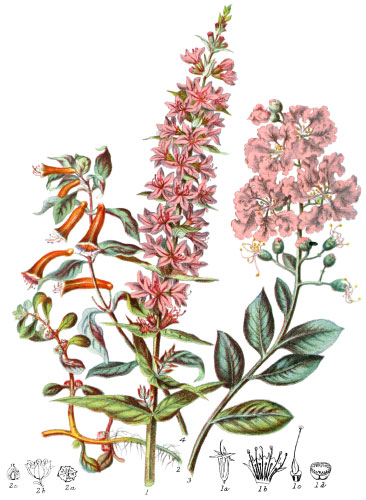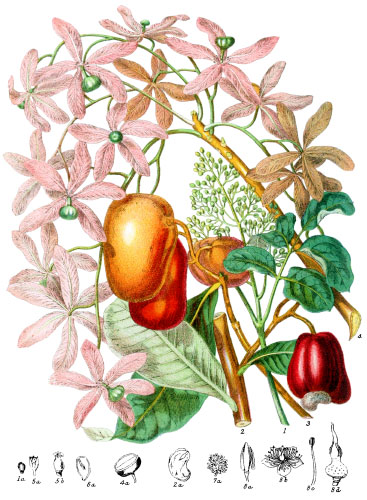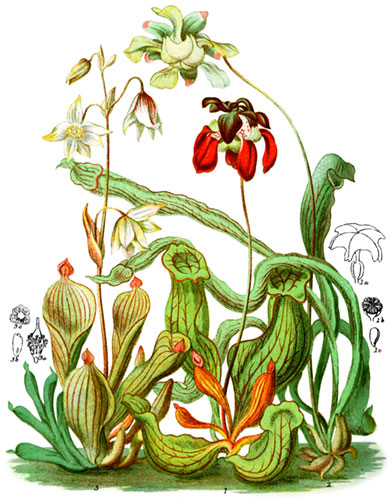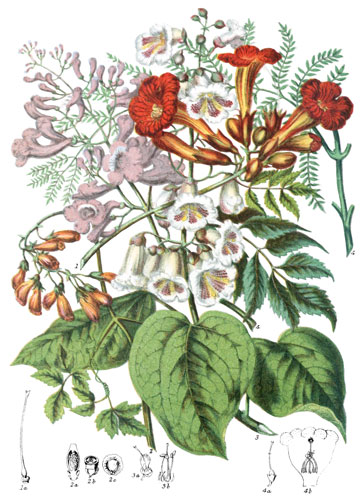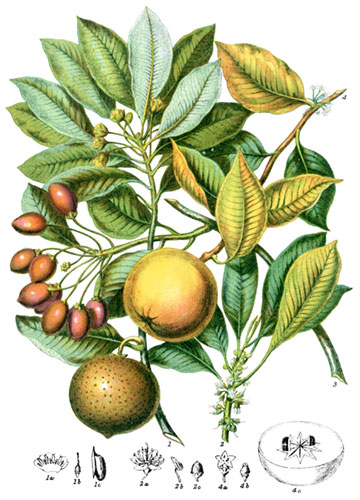Key characteristics
Small trees and shrubs, much branched, often angular irregularly, frequently evergreen, sometimes rooting on other trees. The leaves are alternate, undivided, without stipules, often having resinous glands on the notches at the edges, and on the under surface. The flowers are solitary or on branches. The calyx is above the ovary, entiere, or with four to six lobes. The corolla is of one petal, lobed like the calyx. The stamens are distinct, twice as many as the lobes of the corolla, inserted into a disk; the anthers have two cells, bursting by pores at the top, and sometimes two horns. The fruit is a fleshy berry crowned by the remaining portion of the calyx, succulent, having four to ten cells, with one or many seeds in each. The seeds are minute, and contain fleshy albumen.
This Tribe has most affiity with Ericaceæ.
Astringent properties prevail in the bark and leavs; subacid in the fruit.
Select plants in this order
Not all plants listed are illustrated and not all plants illustrated are listed.
- Vaccinium is a genus of which Britain possesses a few species, North America several.
- V. Myrtillus (1) is frequently seen in favourable localities, in rocky woody places. In Cumberland, it adorns the wood banks of glens and waterfalls, as well as the more open heaths and commons. In the Highalnds of Scotland it is so plentiful as to afford a supply of food to the moor-game, and also much employment to the poor people, who collect the fruit to sell in the market towns for preserving with sugar for winter use. In the form of jelly it is usually one of the various ingredients of a traveller’s repast at a village inn. When the berries are ripe, it is a remarkably pretty plant; but in Switzerland it becomes a more striking embellishment to the scene, particularly when in autumn the leaves change to red. On the highest part of the Simplon Pass the ground is covered with it in a dwarf state, but the tinted foliage adds a very pleasing effect amidst the wide dreary tracts.
- V. Vitis Iæa (2) the Cowberry, is a smaller plant, usually not more than four or five inches high; this is also an Alpine species, and is found in considerable abundance in the North of England, and in all mountainous districts of Europe. In Sweden and Norway, a preserve of the fruit is a constant accompaniment to roast meat.
- V. uliginosum, the Bilberry, is another British species, with large black fruit, the juice more acid, less wholesome, and said to possess narcotic qualities.
- V. formosum, of China, is esteemed sacred; the flowers come forth at the beginning of the year, and are then used as religious offerings by the Chinese in their temples.
- V. padifolium is an evergreen shrub of Madeira: V. meridionale of Jamaica.
- Oxycoccus derives its name from the Greek acid berry; the slender revolute petals distinguish it from Vaccinium.
- O. macrocarpus (3) is the well-known American Cranberry, an early importation from North America; although it can be cultivated in peat districts in this country, the fruit is neither so abundant nor good.
- O. palustris, the British Cranberry, is plentiful in watery bogs of Cumberland and elsehwere; the fruit is agreeable when cooked, and much eaten in the northern counties. The silversmiths of Sweden employ it for an acid to destroy the external particles of copper alloy in silver plate.
- Thibaudia has a more highly developed corolla than is usual in this tribe, and has less of an Alpine character, although the different species inhabit lofty mountains. Some flourish on the Andes of Peru and Quito, and some on the mountains of New Granada; others grow on the Himalayas and Neilgherries of India.
- T. variegata (4) is a native of the mountain-forests of Silhet, the flowers appearing in the cool season, the seed ripening in July.
- T. macrophylla bears an abundant fruit, which is made into wine.
- The flowers of T. Quereme yield an aromatic tincture to the Peruvians, who esteem it as a remedy for toothache.
- Gaylussacia serrata (5) is another of the small evergreen shrubs which adorn the mountains of Silhet, flowering in February.
- Gaylussacia is found also in Java.
Locations
This Tribe abounds in the Temperate regions of the world, particularly in swampy or subalpine countries; some species inhabit the mountains of Central Asia, others belong to the Andes of South America, where a few are parsitical: some are natives of North America, and some belong to the moors, marshes, and mountains of Europe.
Legend
- Vaccinium Myrtillus. Black Whortle-berry. Britain.
- Stamen.
- Seed.
- Vaccinium Vitis Idæa, Red Whortle-berry, or Cowberry. Britain.
- Oxycoccus marcrocarpus, Large Cranberry. America.
- Stamen.
- Thibaudia variegata, Variegated Thibaudia. Himalayas.
- Stamen and Pistil.
- Pistil.
- Stamen.
- Section of Ovary.
- Gaylussacia serrata. Mountains of Silhet.
-
- Vaccinium amenæum, Stamen.
- Section of Fruit.
- Section of Seed.
Explore more
Posters
Decorate your walls with colorful detailed posters based on Elizabeth Twining’s beautiful two-volume set from 1868.
Puzzles
Challenge yourself or someone else to assemble a puzzle of all 160 botanical illustrations.

